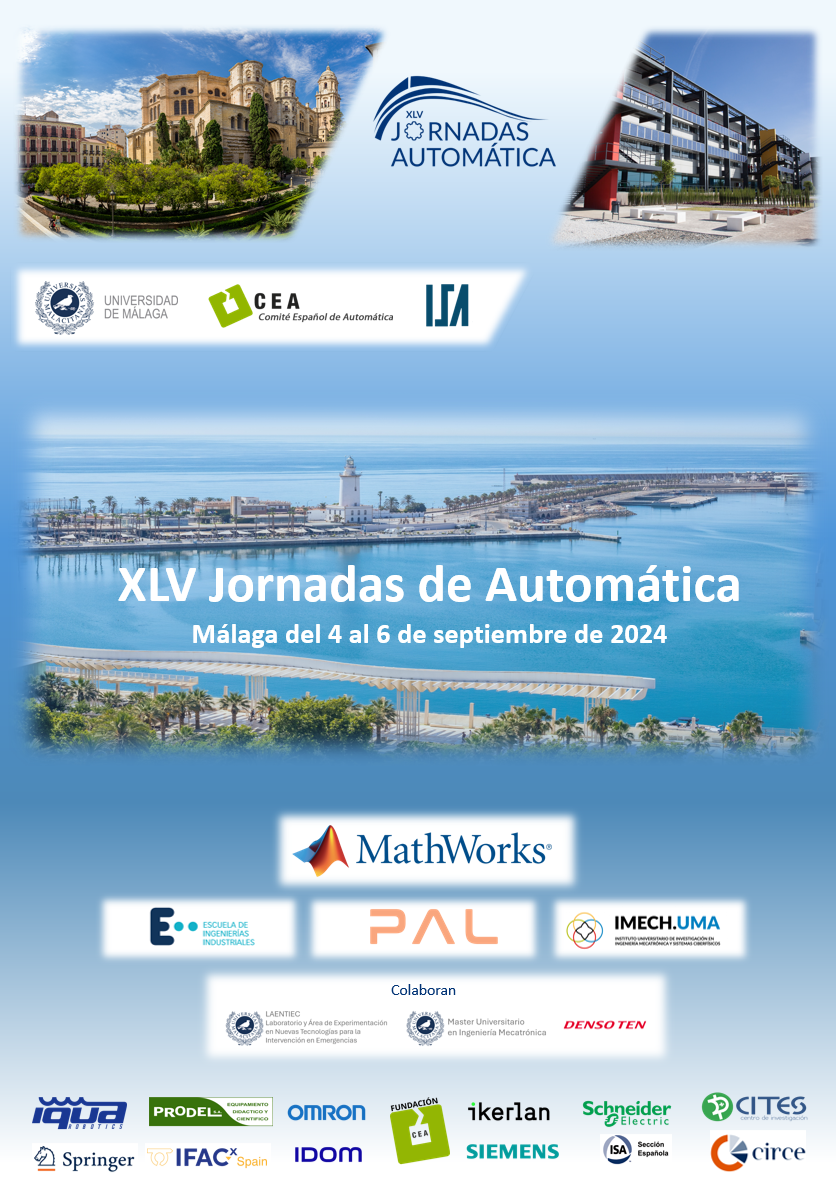Desarrollo de DAECs por GIT-ERM y sistema sensorial para torpedos cilíndricos
DOI:
https://doi.org/10.17979/ja-cea.2024.45.10846Palabras clave:
Energía Renovable Marina, Dispositivos para el Aprovechamiento de la Energía de las Corrientes, Sistema de Control de lastre, Sistema Sensorial basado en Metodología, Medida de VolumenResumen
Para poder transitar hacia una nueva economía baja en carbono en la que se pueda satisfacer la demanda energética a la vez que se reducen los niveles de CO2 emitidos, y con ello poder mitigar los efectos del cambio climático, es razonable impulsar las energías renovables. La energía explotable de las corrientes marinas se encuentra, principalmente, a grandes profundidades. Para poder aprovechar esta energía, GIT-ERM ha desarrollado diferentes dispositivos, fondeados al lecho marino y capaces de variar de modo automático su profundidad y/u orientación mediante un sistema de control de agua de lastre, lo que permite abaratar costes y facilitar su explotación. Este trabajo presenta un breve resumen de los dispositivos desarrollados junto sus accionamientos hidrostáticos que resultan cilíndricos. Además, se presenta el sistema sensorial desarrollado. Este sistema es capaz de medir la cantidad de agua contenida en los tanques cilíndricos ante cualquier orientación. También se presentan una serie de resultados obtenidos del prototipo de laboratorio construido para su validación.
Referencias
ANCRE. 2015. “Decarbonization Wedges.”
Bahaj, A. S., and L. E. Myers. 2003. “Fundamentals Applicable to the Utilisation of Marine Current Turbines for Energy Production.” Renewable Energy 28 (14). https://doi.org/10.1016/S0960-1481(03)00103-4.
Brito, A., and J.L. Villate. 2014. “Implementing Agreement on Ocean Energy Systems.” https://doi.org/10.1115/OMAE2007-29722.
Bustreo, C., U. Giuliani, D. Maggio, and G. Zollino. 2019. “How Fusion Power Can Contribute to a Fully Decarbonized European Power Mix after 2050.” Fusion Engineering and Design 146 (October 2018): 2189–93. https://doi.org/10.1016/j.fusengdes.2019.03.150.
Charlier, R.H., and C.W. Finkl. 2009. “Ocean Energy: Tide and Tidal Power.” In Ocean Energy: Tide and Tidal Power, 1–262. https://doi.org/10.1007/978-3-540-77932-2.
Cruz, J., ed. 2008. Ocean Wave Energy “Current Status and Future Prespectives.” Springer Berlin, Heidelberg. https://doi.org/https://doi.org/10.1007/978-3-540-74895-3.
del Horno, L., E. Segura, R. Morales, and J. A. Somolinos. 2020. “Exhaustive Closed Loop Behavior of an One Degree of Freedom First-Generation Device for Harnessing Energy from Marine Currents.” Applied Energy 276 (October): 115457. https://doi.org/10.1016/j.apenergy.2020.115457.
del Horno, L., J. A. Somolinos, E. Segura, and R. Morales. 2021. “Estudio Comparativo de Algoritmos de Control Para Maniobras de DAECs* de Primera Generación y Dos Grados de Libertad.” Revista Iberoamericana de Automática e Informática Industrial 18 (4): 407–18. https://doi.org/10.4995/RIAI.2021.14974.
del Horno, L., E. Segura, J.A. Somolinos, and R. Morales. 2023. “A New Methodology-Based Sensorial System with Which to Determine the Volume of Liquid Contained in a Cylindrical Tank Subjected to Full Variations in Its Orientation.” Journal of Marine Science and Engineering 11 (12). https://doi.org/10.3390/jmse11122316.
IEA. 2023. “Renewables 2023. Analysis and Forecast to 2028.”
IPCC. 2023. “Summary for Policymakers: Synthesis Report.” Climate Change 2023: Synthesis Report. Contribution of Working Groups I, II and III to the Sixth Assessment Report of the Intergovernmental Panel on Climate Change.
IRENA. 2023. “Reneweble Energy Statistic 2023.”
Khan, J., and G.S. Bhuyan. 2009. “Global Technology Development Status.”
La Portilla, M., A. López Piñeiro, J.A. Somolinos, and R. Morales. 2018. “Modelado Dinámico y Control de Un Dispositivo Sumergido Provisto de Actuadores Hidrostáticos.” Revista Iberoamericana de Automática e Informática Industrial 15 (1): 12–23. https://doi.org/10.4995/RIAI.2017.8824.
López Piñeiro, A. 2012. Boya de fondeo mono-punto giratoria y sumergible, para dispositivos sumergidos, con conexiones eléctricas y ópticas. ES 2 367 616 B2, issued 2012.
López Piñeiro, A., J.A. Somolinos, and R. Morales. 2018. “Control de Un Nuevo Dispositivo de Aprovechamiento de Corrientes Mareales de Segunda Generación.” In XXXIXJornadasdeAutomática, 422–29. Badajoz, España. https://doi.org/10.17979/spudc.9788497497565.0422.
López Piñeiro, A., J.A. Somolinos, L.R. Núñez, E.M. Novoa, and A.M Carneros. 2012. “Dispositivo Para Aprovechar La Energía de Corrientes Marinas. El Proyecto GESMEY, Un Caso de Éxito.” Economía Industrial, no. 386: 135–44. http://oa.upm.es/38548/.
Lund, H., and B. Vad Mathiesen. 2012. “The Role of Carbon Capture and Storage in a Future Sustainable Energy System.” Energy 44 (1): 469–76. https://doi.org/10.1016/J.ENERGY.2012.06.002.
Lynn, P.A. 2013. Electricity from Wave and Tide: An Introduction to Marine Energy. Electricity from Wave and Tide: An Introduction to Marine Energy. https://doi.org/10.1002/9781118701669.
Mathy, S., P. Menanteau, and P. Criqui. 2018. “After the Paris Agreement: Measuring the Global Decarbonization Wedges From National Energy Scenarios.” Ecological Economics 150 (March 2017): 273–89. https://doi.org/10.1016/j.ecolecon.2018.04.012.
Myers, L.E., A.S. Bahaj, C. Retzler, D. Pizer, F. Gardner, C. Bittencourt, and J. Flinn. 2011. “Equitable Testing and Evaluation of Marine Energy Extraction Deliverable D5.2 Device Classification Template.”
Østergaard, P.A., N. Duic, Y. Noorollahi, H. Mikulcic, and S. Kalogirou. 2020. “Sustainable Development Using Renewable Energy Technology.” Renewable Energy 146: 2430–37. https://doi.org/10.1016/j.renene.2019.08.094.
Perez, R., A. Lopez Piñeiro, J.A. Somolinos, and L.R. Núñez. 2018. “Detail Design of a Ballast Control Room for an Underwater Tidal Energy Converter.” Brodogradnja 69 (1): 39–52. https://doi.org/10.21278/brod69103.
REN21, 2023. 2023. “Renewables 2023 Global Status Report Collection, Renewables in Energy Demand.”
Segura, E., R. Morales, and J.A. Somolinos. 2019. “Increasing the Competitiveness of Tidal Systems by Means of the Improvement of Installation and Maintenance Maneuvers in First Generation Tidal Energy Converters-An Economic Argumentation.” Energies, June. https://doi.org/10.3390/en12132464.
Somolinos, J. A., A. López Piñeiro, L. R. Núñez, and R. Morales. 2017. “Dynamic Model and Experimental Validation for the Control of Emersion Manoeuvers of Devices for Marine Currents Harnessing.” Renewable Energy 103 (April): 333–45. https://doi.org/10.1016/j.renene.2016.10.076.
Titah-Benbouzid, H., and M. Benbouzid. 2015. “Marine Renewable Energy Converters and Biofouling: A Review on Impacts and Prevention.” A Review on Impacts and Prevention. EWTEC.
Vazquez, A., and G. Iglesias. 2016. “Grid Parity in Tidal Stream Energy Projects: An Assessment of Financial, Technological and Economic LCOE Input Parameters.” Technological Forecasting and Social Change 104 (March): 89–101. https://doi.org/10.1016/J.TECHFORE.2015.12.007.
Descargas
Publicado
Número
Sección
Licencia
Derechos de autor 2024 Leticia del Horno Diaz, José Andrés Somolinos, Rafael Morales Herrera, Eva Segura

Esta obra está bajo una licencia internacional Creative Commons Atribución-NoComercial-CompartirIgual 4.0.





